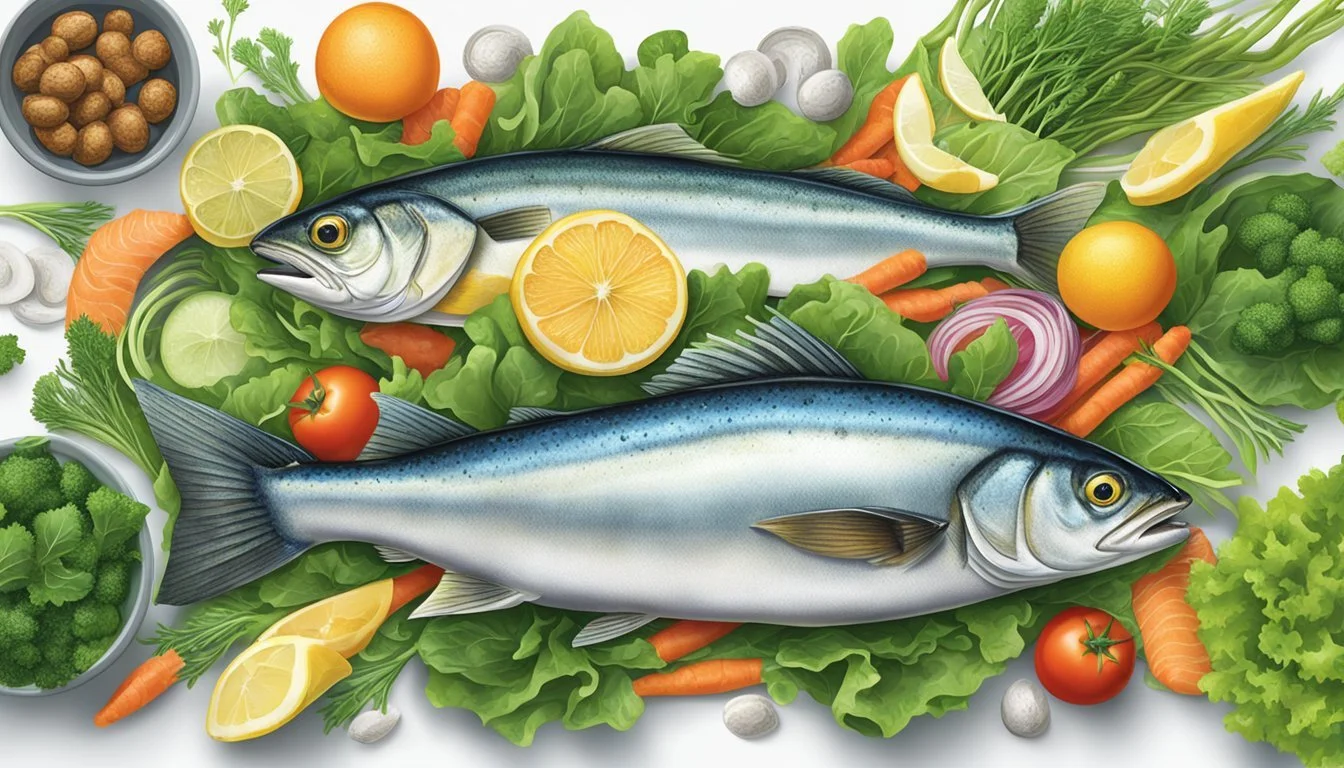Keto Diet: Sustainable Fish Choices for a Healthier Planet and Body
The ketogenic diet, commonly known as the keto diet, emphasizes high-fat, adequate-protein, and low-carbohydrate intake to encourage the body's metabolic state known as ketosis. As health-conscious individuals pursue this diet, the challenge often lies in sourcing macro-nutrient foods that are also sustainable and environmentally conscious, particularly when it comes to seafood (What wine goes well with seafood?).
Fish (What wine goes well with fish?) is a staple in the keto diet due to its rich content of healthy fats, particularly omega-3 fatty acids, and high-quality protein while containing little to no carbohydrates. However, not all fish meet the same criteria for sustainability or nutritional benefit. It's crucial for keto dieters to select fish that not only align with their macronutrient requirements but also have a minimal impact on the aquatic ecosystems.
Sustainable seafood choices are characterized by their abundance in the wild, responsible farming practices, and minimal bycatch. Fish like Atlantic mackerel, salmon, and sardines are often cited as keto-friendly for their favorable fat content and nutrient profile, including vitamins D and B, and minerals like selenium. These fish also tend to rank high in sustainability when sourced correctly, offering a responsible choice for those looking to maintain their ketogenic lifestyle without compromising the health of our oceans.
Fundamentals of Keto Diet
In exploring the keto diet, one must understand macronutrient ranges, recognize the health benefits, and comprehend the metabolic state of ketosis.
Understanding Macronutrient Ranges
The ketogenic diet is characterized by its macronutrient ratio: high-fat, moderate-protein, and low-carbohydrate. It typically aims for 70-80% of calories from fat, 15-20% from protein, and only about 5-10% from carbohydrates. This distribution is essential for triggering a metabolic state called ketosis, where fat becomes the primary source of energy.
Macronutrient Percentage of Daily Caloric Intake Fat 70-80% Protein 15-20% Carbohydrates 5-10%
Health Benefits of Keto Diet
The keto diet may yield several health benefits, as cited in literature and research. These include potential weight loss, improved blood sugar control, and enhanced cognitive function. The diet's emphasis on fats and proteins, while restricting carbohydrates, can lead to a reduction in hunger-stimulating hormones, thereby reducing appetite and promoting satiety.
Ketosis and Ketones
During ketosis, the body switches its energy source from glucose to ketones, which are compounds produced from the breakdown of fats in the liver. Achieving ketosis requires strict adherence to low carbohydrate intake. The presence of ketones in the body signifies that it's using fat as its main energy source, which is the cornerstone of the standard keto diet. Regular monitoring of ketone levels can help individuals maintain ketosis and derive the intended benefits of the diet.
Seafood and the Keto Diet
In the context of a ketogenic diet, seafood stands out as a nutrient-dense food category rich in protein and healthy fats. It is imperative for keto dieters to select varieties that are low in carbohydrates and high in omega-3 fatty acids to meet their dietary requirements.
Best Fish for Keto Diet
Salmon: Often considered the star of keto-friendly fish due to its high content of healthy fats and zero carbs. A 3.5 ounce serving of salmon not only delivers a robust 21 grams of protein but also contributes significantly to the intake of omega-3 fatty acids, crucial for heart and brain health.
Sardines: These small, oily fish are not only budget-friendly but also packed with nutrients. They offer a considerable amount of omega-3s and protein in each serving, making them an ideal choice for someone following a ketogenic diet.
Keto-Friendly Seafood Varieties
Shrimp (What wine goes well with shrimp?) and Crab (how long does crab last?): Both of these seafood options contain trace amounts of carbs but are high in protein, which can help keto dieters maintain muscle mass while in ketosis.
Oysters (What wine goes well with oysters?): Although oysters do have some carbohydrates, they can still be incorporated into a keto diet in moderation. They provide a wealth of other benefits, including vital minerals like zinc.
Selecting Sustainable Seafood
When choosing seafood as part of a ketogenic diet, sustainability is a critical consideration. It includes opting for wild-caught options or those sourced from farms that practice responsible aquaculture.
Wild-caught Salmon: Better omega-3 profile compared to farm-raised, choose MSC-certified where available.
Farmed Shellfish: (What wine goes well with shellfish?) Often sustainable due to their low environmental impact, look for BAP or ASC certification.
Seafood choices like these contribute to a well-rounded, health-conscious ketogenic diet while also considering the well-being of marine ecosystems.
Nutritional Considerations
When following a ketogenic diet, selecting sustainable fish contributes to both personal health and environmental responsibility. The nutritional focus should be on obtaining optimal fats, essential vitamins and minerals, and a balanced intake of omega fatty acids.
Optimal Fats and Oils
Sustainable fish choices on a keto diet should include those high in healthy fats to support the diet's macronutrient distribution, predominantly fats. Salmon, for example, is rich in EPA and DHA, types of omega-3 fatty acids vital for brain health and reducing inflammation. Keto dieters should cook fish with keto-friendly fats like butter or coconut oil to increase the fat content while ensuring that these additions are sustainably sourced.
Important Vitamins and Minerals
Fish provides an array of essential vitamins and minerals crucial for overall health. These include vitamin D and vitamin B12, which are important for bone health and energy metabolism, respectively. Here is a breakdown of some key nutrients found in fish:
Vitamin D: Supports bone health and immune function.
Vitamin B12: Necessary for red blood cell formation and neurological function.
Iron: Crucial for blood health, found in fish like clams (What wine goes well with clams?)and oysters.
Calcium: Important for bones, available in small amounts in fish.
Selenium: A powerful antioxidant found in seafood.
Fish are naturally low in fiber, so keto dieters should consider supplementing with other foods.
Balancing Omega Fatty Acids
A keto dieter should aim for a healthy balance between omega-3 and omega-6 fatty acids. Fish high in omega-3s, like mackerel or sardines, can help correct the typical imbalance of these fats in the Western diet. Omega-3s can reduce the risk of chronic diseases and are anti-inflammatory, while omega-6s—found in many plant oils—are pro-inflammatory when consumed in excess. Sustainable fish options low in contaminants will provide the greatest health benefits for omega-3 fatty acid intake.
Health Impact of Seafood Consumption
Seafood is renowned for its health benefits, particularly due to the presence of omega-3 fatty acids, which are pivotal for heart health and reducing inflammation. In the context of a ketogenic diet, these benefits are especially pertinent.
Cardiovascular Benefits
Seafood consumption is beneficial for heart health because it is usually high in omega-3 fatty acids. Eicosapentaenoic acid (EPA) and docosahexaenoic acid (DHA), which are found in fish like salmon, mackerel, and anchovies, play a significant role in maintaining healthy cholesterol levels and can help reduce the risk of heart disease. Regular intake of these fatty acids is associated with a decrease in triglycerides and blood pressure, thereby supporting overall cardiovascular health.
Anti-Inflammatory Effects
Omega-3 fatty acids inherent in seafood also possess anti-inflammatory properties. Inflammation is a root cause of many chronic diseases, and omega-3s can alleviate inflammatory responses within the body. This anti-inflammatory effect is not only beneficial for chronic conditions such as arthritis but also supports the body's overall well-being.
Cancer and Disease Prevention
Research suggests seafood's antioxidant properties, stemming from various nutrients such as Vitamin C and zinc, may have a role in cancer prevention. Consumption of certain types of seafood is linked to a reduced risk of certain types of cancer due to their ability to potentially inhibit tumor growth. Additionally, the antioxidants help to protect cells from damage that can lead to chronic diseases.
Environmental and Ethical Concerns
When choosing fish within a keto diet, considering the impact on ocean ecosystems and ethical fishing practices is crucial. This section will examine the complexities of overfishing, ocean health, and the debate between farmed and wild-caught fish that keto dieters should be aware of when selecting sustainable seafood options.
Overfishing and Ocean Health
Overfishing poses a significant threat to marine biodiversity and the health of ocean ecosystems. Sustainable fish choices are essential to prevent the depletion of species, many of which are integral to the aquatic food chain. For instance, wild-caught tuna is often in demand but can contribute to overfishing if not responsibly sourced.
Organizations such as the Monterey Bay Aquarium Seafood Watch provide guidance on which fish species are more sustainable, helping consumers make informed choices. They often recommend fish that are abundant and managed through effective, environmentally conscious fishing practices.
Farmed vs. Wild-Caught Fish
The sustainability of farmed versus wild-caught fish is a complex issue. On one hand, farmed fish like farmed salmon can contribute to pollution through fish waste and uneaten feed, and they may also contain higher levels of contaminants such as PCBs (polychlorinated biphenyls) due to the feed they are given. In contrast, while wild-caught fish may have a smaller carbon footprint, certain species may be more prone to overfishing or carry higher levels of mercury.
Some aquaculture practices, however, are considered more sustainable. For example, farmed Arctic char is often raised in land-based, closed systems that greatly reduce the risk of disease, pollution, and escape into wild populations. Diners following a keto diet who are concerned about sustainability and ethical practices are encouraged to seek out such alternatives.
Incorporating Seafood into a Keto Diet
Seafood is an excellent source of high-quality protein and healthy fats, making it ideal for keto dieters. This section details how to integrate seafood into a ketogenic diet effectively and enjoyably.
Meal Planning and Recipes
When planning keto meals, aim for variety to ensure a range of nutrients. Seafood can be paired with ingredients like olive oil, butter, coconut oil, and avocado to enhance flavor and fatty acid content. Here's a sample meal plan:
Monday Lunch: Grilled salmon salad with mixed greens, avocado, and a vinaigrette made with olive oil.
Wednesday Dinner: Shrimp cooked in butter with a side of roasted asparagus.
Friday Snack: Tuna-stuffed avocado boats topped with cheese.
For keto-friendly recipes, consider the following:
Cajun Shrimp and Cauliflower Rice: Uses shrimp seasoned with Cajun spices and served over a bed of cauliflower rice sautéed in olive oil.
Salmon with Creamy Dill Sauce: Features baked salmon covered in a sauce made from cream cheese and fresh dill.
Keto Seafood Alternatives
For those seeking alternatives to traditional seafood dishes that fit into a ketogenic diet, plenty of options are available. They can select shellfish like crab or oysters, which, while containing some carbohydrates, are low enough to fall within keto guidelines. For a diverse food list that complements seafood, they might include:
Vegetables: Salad, cabbage, mushrooms, and cauliflower.
Fats: Eggs, olive oil, and butter for cooking and enhancing flavor.
Nuts: Almonds or walnuts for a crunchy snack or salad topping.
By incorporating these keto staples into meals with seafood, individuals can create satisfying, nutritious dishes that align with their dietary goals.
Special Considerations for Keto Dieters
When following a keto diet, one needs to carefully select seafood that aligns with the high-fat, low-carbohydrate regime. Adopting a pescatarian approach or accounting for allergies and intolerances are critical to maintaining both health and diet efficacy.
Pescatarian Keto Approach
The pescatarian keto diet incorporates seafood as a primary protein source, ensuring that keto dieters receive the necessary macronutrient ratio. A typical pescatarian keto diet consists of:
70-80% fat
20-30% protein
5% or fewer carbohydrates
Seafood choices high in omega-3 fatty acids, such as salmon, mackerel, and sardines, are ideal as they support keto diet goals and contribute to overall health. These options facilitate weight loss by providing satiety while aligning with the macronutrient requirements of a ketogenic lifestyle.
Dealing with Allergies and Intolerances
Those with allergies and intolerances must navigate the keto diet with caution, particularly when it comes to seafood and shellfish, common allergens. One should:
Identify safe options: Consult with a healthcare provider for testing and identification of safe seafood.
Read labels: Always check labels for potential allergens in seafood products.
Prepare separately: Avoid cross-contamination by preparing allergen-free seafood separately.
By addressing these considerations, individuals with allergies and intolerances can still reap the weight loss benefits of a keto diet without compromising their well-being.
Culinary Tips and Tricks
When preparing keto-friendly fish dishes, one should consider the cooking methods that preserve the delicate flavors and textures of fish. Baking and broiling are excellent options, as they require minimal added fats and can be enhanced with keto-approved ingredients.
Seasoning plays a critical role in fish cuisine. To infuse variety into the keto diet, try utilizing a range of spices and herbs. Using them in rubs or marinades before cooking can significantly elevate the taste. Ghee is another keto-friendly fat that adds rich, nutty flavors to fish and can withstand high cooking temperatures, making it suitable for searing or frying.
Almond flour serves as a versatile, low-carb alternative for coating fish. It can be used to create a crust, combining it with grated Parmesan or herbs for an added flavor dimension. Here is a simple way to use almond flour for coating fish:
Ingredient Quantity Almond flour 1 cup Grated Parmesan 1/2 cup Garlic powder 1 tsp Paprika 1/2 tsp Salt To taste Pepper To taste
Mix the dry ingredients in a bowl. Dip the fish fillets in beaten eggs, then dredge in the almond flour mixture until well-coated. Bake or fry as desired.
For food preparation, it’s crucial to ensure fish is fresh or properly thawed if frozen. Patting the fish dry before seasoning or coating with almond flour can help achieve a crispier texture when cooked. Remember, a successful keto dish maintains both the natural essence of the fish and the regimented balance of macronutrients.
Case Studies and Real-world Applications
This section delves into personal success stories and summarizes significant research findings related to ketogenic diets, sustainable fish consumption, and health outcomes.
Keto Transformation Stories
Individuals have documented significant health transformations while adhering to a ketogenic diet, often including sustainable fish as a staple food source. These individuals typically report weight loss and improvements in heart health. Keto dieters often substitute the Standard American Diet, high in carbohydrates and processed foods, with one that includes healthier fats and proteins. For instance, the Mediterranean keto diet is a variant that combines the traditional high-fat, low-carb keto principles with the Mediterranean focus on seafood and healthy fats, leading to reported improvements in wellbeing and cardiovascular health.
Recent Research and Findings
Research Findings on Ketogenic Diets and Fish Consumption:
Study Focus Findings Weight Loss Ketogenic diets have been linked to more effective weight loss compared to low-fat diets. Heart Health Higher fish consumption has been associated with a reduced risk of cardiovascular diseases. Sustainable Seafood Eating at least eight ounces of sustainable seafood per week is recommended for a balanced keto diet. Covid-19 No direct studies link keto diets and Covid-19 outcomes. Diet Comparison Keto diets, including moderate protein intake, show potential benefits over the Standard American Diet in several studies.
Research also explores specific diets like the carnivore keto diet, which emphasizes animal products and is a more restrictive form of the traditional ketogenic diet. While studies on its long-term effects are ongoing, preliminary data suggest potential health benefits, but also highlight a need for a balanced approach to nutrient intake.
Final Thoughts and Future Directions
The seafood industry and keto diet trends are intertwined in the pursuit of healthful, ethical choices. As individuals increasingly opt for a ketogenic lifestyle, the demand for keto-friendly seafood rises, propelling the industry toward practices that prioritize sustainability.
Sustainable Keto Seafood Choices:
Wild-caught fish: Promotes ethical harvesting
Certified farms: Ensures proper welfare and environmental standards
Small, oily fish: Lower mercury risk and high in omega-3s
Industry experts anticipate the diversification of keto-friendly seafood as a key trend for the future. Ethical practices, such as traceability and eco-labeling, are becoming vital for consumers making informed decisions.
Health Outlook:
Nutrient-rich options: Keto dieters seek seafood high in essential fats and low in contaminants.
Holistic health: A balance between physical well-being and environmental responsibility.
Future directions focus on strengthening the alliance between nutritionists, environmentalists, and the seafood industry. Innovations, like aquaculture technology, may enhance the viable selection of keto-friendly seafood while decreasing ecological footprints. Additionally, consumer education is pivotal in promoting ethical choices and broadening the understanding of nutrition's role in long-term health.
As individuals align their dietary habits with their values, the industry is prompted to adapt, suggesting a positive trajectory towards health and sustainability. Thus, as the ketogenic diet evolves, the importance of continued research and ethical consideration in seafood choices remains integral.









